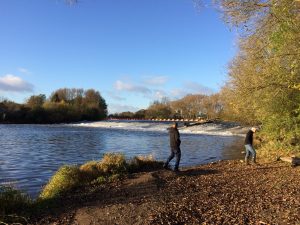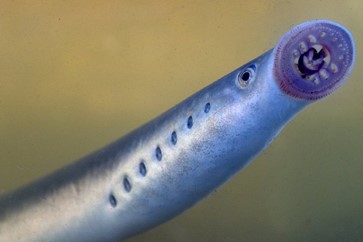
Written by Aaron Batsman, Waterways and Environment Apprentice for Unlocking the Severn.
Introduction to the Lamprey
Lamprey are a descendant of the jawless fish family that pre-dates the ancestors of true fish that we see today. This primeval creature has no proper bones and its appearance resembles that of an eel. Despite their similar body shape, they are not closely related. Lamprey are in fact more closely related to sharks!
An adult lamprey’s mouth is circular and filled with backwards facing teeth. Their round mouths act like suckers, which allows them to cling to the bottom of a waterway as well as latching onto larger fish to feed.
There are three lamprey species in the UK, the Brook Lamprey, the River Lamprey and the Sea Lamprey. To start, we will take a look at the smallest of the lamprey, who has a slightly different use for its sucker mouth other than feeding.
Brook Lamprey (Lampetra Planeri)
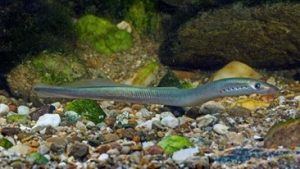
Brook Lamprey. Photo from The Woodland Trust website. Credit: Blickwinkel / Alamy Stock Photo
Brook lamprey spend their lifecycle in rivers and streams and do not migrate to the ocean to breed. Once the lamprey reaches maturity, its digestive functions stop and it cannot feed. They will then migrate upstream to spawn.They spawn in shallow water between April and June, this is the best time to try and spot them as they usually spend a lot of their time buried in sandy sediments. During their spawning months, the brook lamprey use their circular sucker mouths to build nests out of rocks where their eggs are deposited.
Appearance
15-25 cm adult length
Green/grey in colour
Habitat
Brooks, streams, rivers and sometime lakes
Diet
Only feeds in larval form by filtering detritus
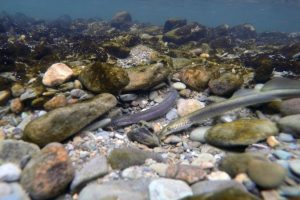
Brook Lampreys Nest Building, March 2016. Photo from Lamprey Survey website.
River Lamprey (Lamprey fluviatilis)
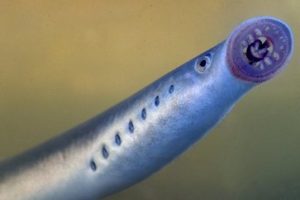
River Lamprey. Photography: Jack Perks, courtesy of BBC News
The river lamprey is a larger species of lamprey in comparison to the brook lamprey. This terrifying looking creature uses it sucker like jaws and backwards facing teeth to latch on to fish and feed from it. Ripping away chunks of flesh and engorging itself on the fish’s bodily fluids. Nice!
Adult river lamprey live in the sea and migrate back to freshwater to spawn. This migration to freshwater usually occurs during autumn and spring and spawning takes place from April to May. River lamprey spawning grounds are areas of small stones and gravel with slow flowing water. The female river lamprey can lay up to 25,000 eggs that are fertilised by several males. The migration and spawning period is when you are most likely to see river lamprey as the young lamprey spend several years buried in the silt of their spawning grounds.
Appearance
Up to 50cm adult length
Blue/grey in colour
Habitat
Ocean, Rivers and Wetlands
Diet
Parasitically feed on river fish in particular herring and flounder
Larvae feed on micro-organisms
Sea Lamprey (Petromyzon marinus)

Sea Lamprey. Image from British Sea Fishing.
The last and largest of the lamprey found in the UK is the sea lamprey. Similarly to the river lamprey, sea lamprey use their specially designed disc shaped mouths to attach themselves and feed off marine fish. Sea lamprey aren’t fussy eaters and feed on any fish, even large basking sharks have been found with lamprey attached to them.
Other comparisons can be draw between the sea and river lamprey. They both migrate from the sea to freshwater environments to spawn and their young, in the larval stages remain in the freshwater for a number of years before returning to the ocean. The main difference between the sea and river lamprey is the time spent in the marine environment, which tends to be considerably longer for the sea lamprey.
Appearance
Up to 1m adult length
Mottled Brown/grey in colour
Habitat
Ocean, Rivers and Wetlands
Diet
Parasitically feed on fish
Larvae feed on algae & bacteria
Threats & Conservation
The problems
Several human impacts are threatening all the species of lamprey in the UK. Pollution and habitat loss/degradation are the biggest threats to lamprey. Spawning sites of all three species of lamprey require good water and substrate quality. With the spawning sites of lamprey being impacted by humans, the three species of lamprey as less likely to successfully spawn and produce young.
River and sea lamprey both travel from the sea to freshwater rivers to spawn. The restriction of this spawning migration by man-made objects, such as weirs has and is continuing to impact on these species of lamprey.
Protective efforts
These impacts mentioned above have lead to a significant decline in populations of the sea, river and brook lamprey. This decline in number of lamprey means they have been placed as rare under the European Commission’s habitat directive and sea and river lamprey are named in the UK Biodiversity Action Plan. The lamprey are also listed on the International Union for Conservation of Nature (IUCN) Red List of Threatened species. Being placed under such directives is a step in the right direction for the lamprey. Measures are put in place to attempt to restore populations of these rare species.
Other attempts are being made to help the lamprey by addressing the physical barriers that prevent their migration up river. Check out the Unlocking the Severn webpage (https://www.unlockingthesevern.co.uk/) which is just one example of a project that aims to provide passage for fish past obstacle such as weirs. Though this project is aimed at the twaite shad it will also benefit countless other species of fish in the River Severn. A similar project, focussing more on lampreys, saw the installation of ‘lamprey tiles’ on man-made barriers to allow the lamprey to use their sucker mouths to climb up the barrier and proceed upstream (See https://www.bbc.co.uk/news/uk-england-34149881 for more information).
Summary
– Lamprey are prehistoric creatures that are under threat from humans
– There are 3 types of lamprey found in British waters: Sea, river and brook lamprey
– Lamprey are now recognised as being under threat and rare
– Directives and projects exist to protect this species and help restore its populations
Thank you for reading my blog post. If you were at all like me and didn’t know what on earth a lamprey was I hope this has given you an insight into the rare and primeval species that dwell in our waters.
Photo credits:
Header Image: River Lamprey by Jack Perks Wildlife Media, from BBC News
Brook Lamprey: 1: https://www.woodlandtrust.org.uk/trees-woods-and-wildlife/animals/fish/brook-lamprey/ 2: https://lampreysurveys.com/2016/03/20/brook-lamprey-spawning-season/
Sea Lamprey: https://britishseafishing.co.uk/sea-lamprey/
River Lamprey: https://www.bbc.co.uk/news/uk-england-nottinghamshire-48533329


